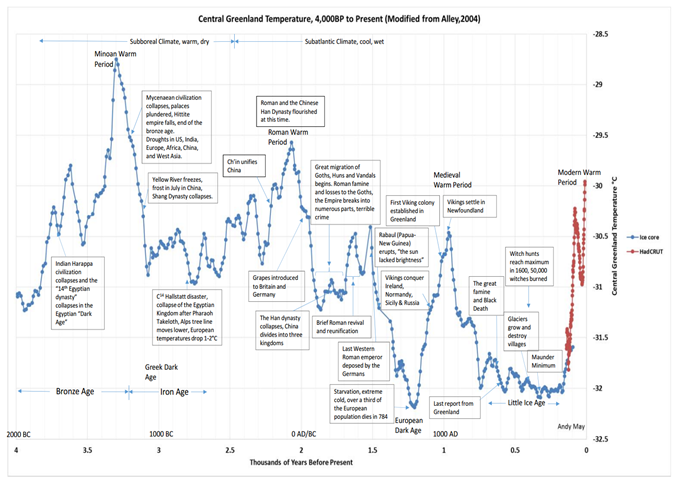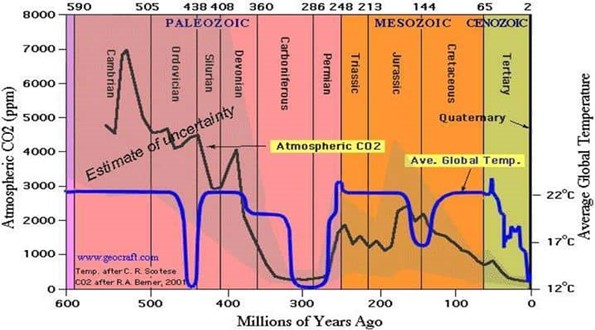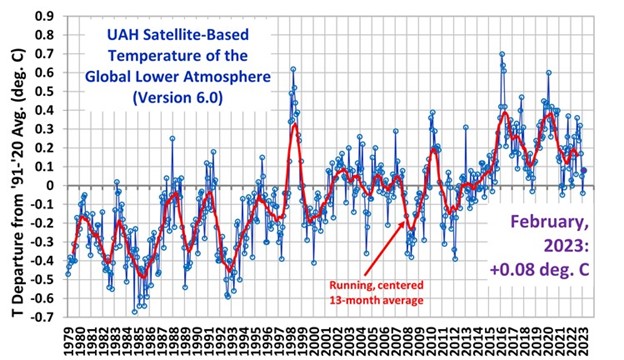Cold weather kills 20 times as many people as hot weather, according to an international study analyzing over 74 million deaths in 384 locations across 13 countries.

If one goes back further in geologic times, you have even more evidence that today's temperatures are normal. Note that in the following plot of temperature and carbon dioxide (CO2) over the past 600 million years, the estimated range in temperatures of Earth is from 12oC to 22oC, with the mean of 17oC. Clearly, we are at the low-end today at 15o C as we are still warming from the last glacial period, which ended over 10,000 years ago.
Advertisement

The modest, beneficial warming that has been experienced across the world since the end of the Little Ice Age, slightly more than 1o Celsius, has essentially stopped, as can be seen in the following satellite-based temperature record. Indeed, the February 2023 "average temperature" was about the same as the 1991 – 2020 average.

No informed person would call this temperature record "fast-rising" or a "climate emergency," as proclaimed by the UN, mainstream media and climate activists.
So, what causes climate change, pro-lifers may be asked. Here is how I suggest they respond:
Temperature trends apparently follow in accordance with solar cycles, and indeed, we may be entering a Grand Solar Minimum when the Sun could be at its weakest in the past 300 years. This could result in significant global cooling, something we need to prepare for. The Epoch Times reportedon November 23, 2021:
Advertisement
In an exclusive interview, scientist Valentina Zharkova told The Epoch Times that her 2015 paper predicting the onset of a grand solar minimum between 2020 and 2053 has been borne out, prompting her to warn that temperatures could soon rapidly fall.
Grand solar minima last for multiple solar cycles, during which the Sun produces less energy and sunspot activity is low. During a previous grand solar minimum, the Maunder minimum between 1645 and 1715, glaciers expanded and the River Thames in England frequently froze over.
Professor Zharkova has a PhD from the Solar Division of the Main Astronomical Observatory, Kyiv, Ukraine. She is now a Professor in Mathematics at Northumbria University in the United Kingdom. In "Modern Grand Solar Minimum will lead to terrestrial cooling," her editorial published on August 4, 2020 in the journal Temperature, which publishes papers related to interactions between living matter and temperature, Professor Zharkova wrote:
This period [upcoming grand solar minimum in which solar magnetic field and its magnetic activity will be reduced by 70%] has started in the Sun in 2020 and will last until 2053. During this modern grand minimum, one would expect to see a reduction of the average terrestrial temperature by up to 1.0°C, especially, during the periods of solar minima between the cycles 25–26 and 26–27, e.g., in the decade 2031–2043.
The reduction of a terrestrial temperature during the next 30 years can have important implications for different parts of the planet on growing vegetation, agriculture, food supplies, and heating needs in both Northern and Southern hemispheres. This global cooling during the upcoming grand solar minimum 1 (2020–2053) can offset for three decades any signs of global warming and would require inter-government efforts to tackle problems with heat and food supplies for the whole population of the Earth.
Discuss in our Forums
See what other readers are saying about this article!
Click here to read & post comments.
5 posts so far.